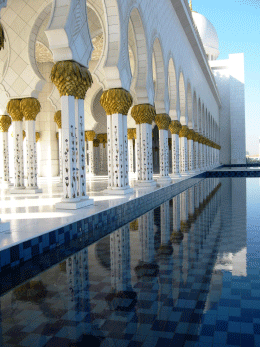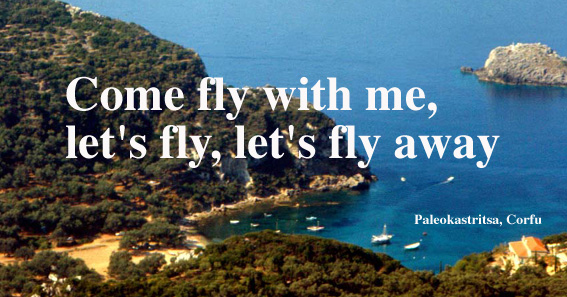
Abu Dhabi: a dream made real
...it's a city of parks and gardens; you don't need to drive into the desert
to find a green oasis. The oasis is here.
...it's a city of parks and gardens; you don't need to drive into the desert
to find a green oasis. The oasis is here.
At night, it looks like a dream from the Arabian Nights, as it rises, moonlit, from its desert landscape; by day, in the merciless sunlight, its glistens wedding-cake white, as its classic domes and minarets reach for the sky above. This is the spectacular new mosque that not only defines Abu Dhabi, its home, but also Mid Eastern Islam.
With its Moorish archways and classic Arab minarets, the mosque is huge - its main prayer hall designed to accommodate up to 9,000 worshippers. White marble predominates in the exterior courtyard and inside the main building. Sinuous floral designs, in coloured stone and pearlshell, inset into white marble floors and pillars, are visually thrilling. The world's largest hand-made carpet is here, made in Iran and measuring 5,627 m2 (60,570 sq ft). It weighs 47 tons. And if you look up, as you will, there it is: the world's largest chandelier - a 10m x 15m over-the-top dazzler.

 The Sheikh Zayad Mosque: a dream in white marble
The Sheikh Zayad Mosque: a dream in white marble

 Inside the huge prayer hall; the main chandelier; floor inlay detail
Inside the huge prayer hall; the main chandelier; floor inlay detailI am in Abu Dhabi briefly, staying at the ultra luxe and perfectly positioned Hilton, one of three Hiltons in the city. It overlooks the Corniche, the city's seaside promenade and the golden sand of its private beach. The hotel has a fitness centre, three pools, three tennis courts and a luxurious spa. Be sure to dine at the Hilton's Le Terrazza restaurant and there's live music at the Jazz Bar. The city centre is just ten minutes away and if you're in the mood for shopping, head for Marina Mall. It offers everything you seek - and then some.

Abu Dhabi is the capital of the United Arab Emirates and it lies on a T-shaped island jutting into the Persian Gulf from the central western coast. With a population approaching one million, the city is the home of the Emirati Royal Family and important government offices. Affluent and forward-looking, the city is more Westernized than many other Arab cities and although it's one of the world's largest producers of oil, it is currently diversifying its economy through investments in financial services and tourism.

Qasr al-Hosn is the oldest (1761) building here; before oil was discovered in 1958, fishing, pearl diving, camel herding and growing dates typified the region's economy. It became a tribal confederation in the 18th century. A hundred years later, the Abu Dhabi and neighbouring Dubai tribes parted company and today the two cities are friendly rivals. The visionary Sheikh Zayed became Abu Dhabi's ruler in 1966 and he was instrumental in the creation of the United Arab Emirates. After his death in 2004, his son Sheikh Khalifa bin Zayed Al Nahyan became the hereditary ruler of Abu Dhabi (UAE)
Abu Dabi is hot. I am here in August, en route to Iran. Out at the airport, transferring from one Etihad flight to another (this is Abu Dhabi's national carrier, recently voted world’s leading airline by more than 180,000 travel industry professionals from over 175 countries) stepping outside was like stepping into a blast furnace, as the wind whistled in from the desert. Cooler weather prevails between November and March, so plan your visit accordingly. But don't worry. All of Abu Dhabi is air-conditioned. This city of broad boulevards, lined with palms, is also one of the cleanest I have ever seen. And it's a city of parks and gardens; you don't need to drive into the desert to find a green oasis. The oasis is here.
I have just a few days here, so I make the most of my stay. The city tour, for starters, gives me a close up look at that changing skyline - plus a visit to a Gold Market, where you can purchase not only gold but exquisite jewelry. I could have gone out into the desert for a 4-wheel drive adventure that includes falconry, dinner and belly dancing (the latter was not on the menu; it was Ramadan) but I opted for dinner on a dhow, a converted fishing vessel. Our delightful Egyptian host served up six delicious courses including lobster and lamb, as we watched the brilliantly lit city skyline glide past, reflected on the black water. The dhow was air-conditioned and prettied up in pink.
What I notice immediately here in Abu Dhabi is its cultural diversity. Most of the inhabitants are expatriate workers from India, Pakistan, Eritrea, Ethiopia, Somalia, Nepal, Bangladesh, Sri Lanka, the Philippines, the United Kingdom and various countries from across the Arab world. The native-born population are Arabic-speaking Persian Gulf Arabs who are part of a clan-based society. The Al Nahyan family, part of the al-Falah branch of the Bani Yas clan, rules the emirate and has a central place in society. Representing this amazing cultural mix are two people I meet during my short visit. One is Humnath, the Nepali concierge at the Hilton, efficient and charming. The other is equally charming white-robed Emirati airport safety officer Saleh Al Hosani, who is also a date farmer. I meet him in the date market and he tells me about (and lets me taste) the many different date varieties he produces.

What makes Abu Dhabi interesting, for me, is not just what is here now - a dramatic skyline that changes from month to month and a splendid new Formula One car racing circuit - but what is planned for the future. And the future, in Abu Dhabi, is tomorrow, not next year. What was once a sleepy settlement of palm-frond huts and Bedouin encampments has, in the planning stage or underway, four museums, a performing arts center and 19 art pavilions designed by celebrated architects like Frank Gehry, Zaha Hadid and Jean Nouvel. Just one component of a $27 billion residential, office and hotel development planned for Saadiyat Island (Island of Happiness), the 670-acre cultural district's Performing Arts Centre will house five theatres – a music hall, concert hall, opera house, drama theatre and a flexible theatre with a combined seating capacity for 6,300.
Abu Dhabi is now, more than ever, a gateway not just to the Arabian desert but to the world. Stopover for a day or two on your way to someplace else - remember, the FIFA Club World Cup UAE will be held here from 9-19 December. Or come just to see and admire this exciting desert metropolis.



.jpg)






